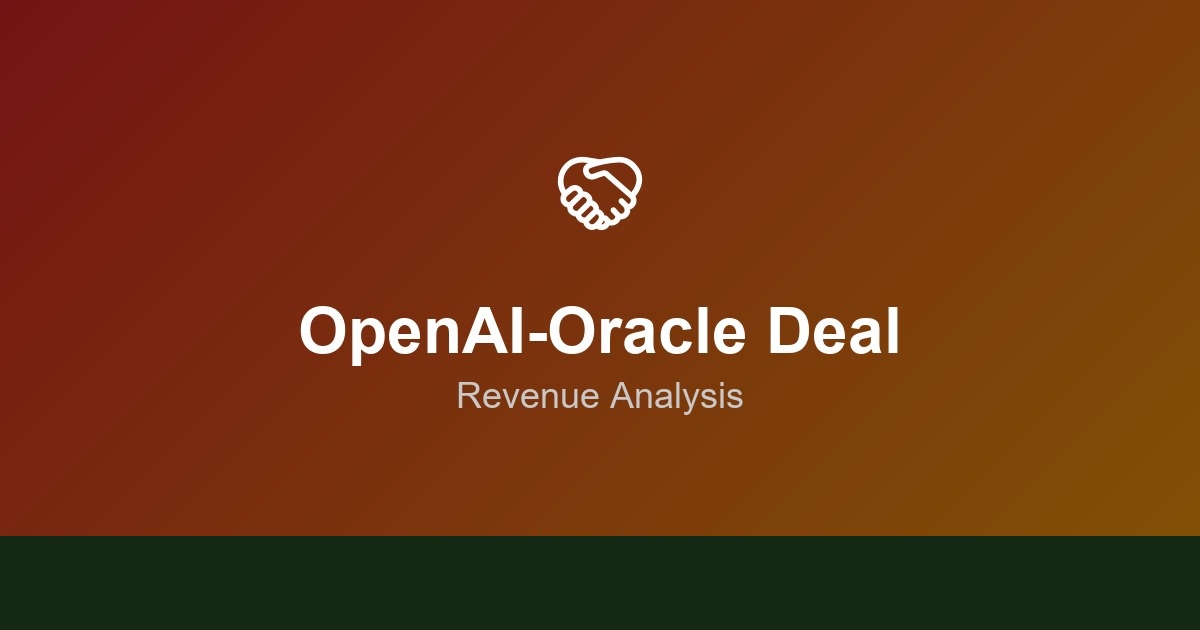Beyond the Hype: OpenAI's $300B Oracle Deal and the AI Revenue Gap

OpenAI's landmark $300 billion deal with Oracle for cloud computing infrastructure has sent shockwaves through the tech world. While on the surface a testament to the incredible computational power required by modern AI, this deal also serves as a critical signal to enterprise leaders about a growing concern: the widening gap between massive AI investments and tangible revenue generation. This "AI revenue gap" is a challenge that every organization must address to ensure their AI initiatives deliver real business value.
_The following content is generated by Manus AI._
OpenAI's landmark $300 billion deal with Oracle for cloud computing infrastructure has sent shockwaves through the tech world. While on the surface a testament to the incredible computational power required by modern AI, this deal also serves as a critical signal to enterprise leaders about a growing concern: the widening gap between massive AI investments and tangible revenue generation. This "AI revenue gap" is a challenge that every organization must address to ensure their AI initiatives deliver real business value.
The sheer scale of the OpenAI-Oracle deal underscores the resource-intensive nature of AI development. It is a clear indicator of the immense infrastructure required to train and deploy large-scale AI models. This trend is not unique to OpenAI; companies across all sectors are pouring billions into AI, hoping to unlock its transformative potential. However, the financial returns on these investments have been slow to materialize for many. A recent MIT report found that a staggering 95% of generative AI pilots at companies are failing to achieve rapid revenue acceleration, with the vast majority stalling without a measurable impact on the profit and loss statement [1].
This disparity between investment and return can be attributed to several factors. Many organizations have adopted a technology-first approach, investing in AI without a clear business case or a well-defined problem to solve. This "AI for AI's sake" mentality often leads to projects that are technically impressive but fail to deliver measurable business outcomes. Furthermore, the scarcity of AI talent, challenges with data quality and governance, and the inherent difficulty in quantifying the ROI of AI initiatives all contribute to the widening revenue gap.
For enterprise decision-makers, the OpenAI-Oracle deal should serve as a catalyst for a strategic shift in their approach to AI. Instead of being mesmerized by the hype, leaders must focus on a disciplined, ROI-driven strategy. This begins with a move away from speculative AI projects and a renewed focus on identifying high-impact use cases that are directly tied to business objectives. A thorough analysis of existing business processes can reveal opportunities where AI can deliver the most significant value, whether through cost savings, revenue growth, or improved operational efficiency.
To bridge the AI revenue gap, organizations must also prioritize the development of a robust data strategy. High-quality, well-governed data is the lifeblood of any successful AI initiative. This requires a concerted effort to break down data silos, ensure data accuracy and consistency, and establish clear data governance policies. Furthermore, investing in the upskilling and reskilling of the workforce is crucial. A cross-functional team, comprising both technical experts and business leaders, is essential for translating AI capabilities into tangible business value.
The journey to AI-driven profitability is a marathon, not a sprint. The OpenAI-Oracle deal is a powerful reminder that while the potential of AI is immense, the path to realizing that potential is fraught with challenges. By adopting a strategic, ROI-driven approach, focusing on measurable outcomes, and investing in the right talent and infrastructure, enterprise leaders can navigate the complexities of the AI landscape and unlock the true transformative power of this technology. The time for AI experimentation is over; the era of AI accountability has begun.
References
[1] Fortune. (2025, August 18). *MIT report: 95% of generative AI pilots at companies are failing*. Retrieved from https://fortune.com/2025/08/18/mit-report-95-percent-generative-ai-pilots-at-companies-failing-cfo/
Ready to Implement AI in Your Enterprise?
Our team of AI experts can help you navigate the complex landscape of AI infrastructure and implementation. Book a free consultation to discuss your specific needs.
Book Free Consultation